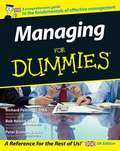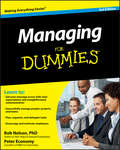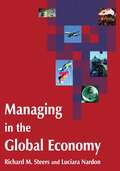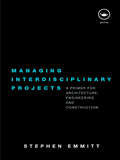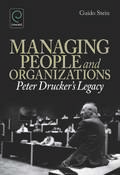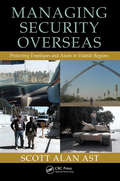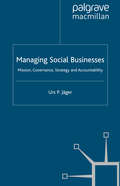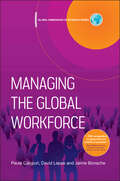- Table View
- List View
Managing Football
by Sean Hamil Simon ChadwickManaging Football is the first book to directly respond to the rapid managerial, commercial and global development of the sport and offers a thorough analysis of how the football industry can meet the challenges that flow from these developments. Expertly edited by two well known specialists in football business management, it draws together the work of a world-class contributor team to form a comprehensive analysis of the most important issues facing the managers of football businesses across the world. The cutting edge analysis examines all the important business challenges in the football industry and the management of football businesses and covers all of the key football markets including England, Spain, France, Italy, Germany, Australia, North America, China, South Africa, South Korea, the Netherlands & Belgium, and Mexico. Managing Football is simply a must-read for anyone studying or working in football business management and is set to be an important landmark in this rapidly moving and globally expansive field.
Managing Football
by Simon Chadwick Sean HamilManaging Football is the first book to directly respond to the rapid managerial, commercial and global development of the sport and offers a thorough analysis of how the football industry can meet the challenges that flow from these developments. Expertly edited by two well known specialists in football business management, it draws together the work of a world-class contributor team to form a comprehensive analysis of the most important issues facing the managers of football businesses across the world. The cutting edge analysis examines all the important business challenges in the football industry and the management of football businesses and covers all of the key football markets including England, Spain, France, Italy, Germany, Australia, North America, China, South Africa, South Korea, the Netherlands & Belgium, and Mexico. Managing Football is simply a must-read for anyone studying or working in football business management and is set to be an important landmark in this rapidly moving and globally expansive field.
Managing For Dummies (For Dummies)
by Richard Pettinger Bob Nelson Peter EconomyIf you're having trouble motivating your employees, need to resolve a conflict, or want to learn how to better monitor your employees’ performance, this straight-forward guide will take you step by step through every aspect of managing. Packed with expert advice on team-building, communication skills, identifying talented employees, and letting go of staff, Managing for Dummies takes the stress out of what can be an intimidating and high-pressured job. The book will be adapted from the current US edition of Managing for Dummies. Existing content will be revised to reflect essential UK information including: UK-specific case studies, including references to recognisable UK businesses UK business practice, including ethics, employee and employers rights and responsibilities, hiring and firing - with reference to UK law UK websites UK financial information
Managing For Dummies
by Bob Nelson Peter EconomyThe fast and easy way to learn how to manage people, projects, and teams Being a manager can be an intimidating and challenging task. Managing involves teaching new skills to employees, helping land a new customer, accomplishing an important assignment, increasing performance, and much more. The process of management can be very challenging at times, but it can also bring you a sense of fulfillment that you never imagined possible. Managing For Dummies, 3rd Edition is perfect for all levels of managers. This clearly written, easy-to-understand guide gives you practical advice on the most important aspects of managing, such as delegating as opposed to ordering, improving employees' performances, getting your message across, understanding ethics and office policies, team building and collaboration, and much more. Tips and advice for new and experienced managers All-new chapters on employee encouragement and corporate social responsibility Guidance on managing employees by leveraging the power of the Internet Managing in today's lightning-speed business world requires that you have the latest information and techniques for getting the job done. Managing For Dummies, 3rd Edition provides you with straightforward advice and up-to-the-minute strategies for dealing with anything that comes your way.
Managing For Dummies
by Bob Nelson Peter EconomyThe fast and easy way to learn how to manage people, projects, and teams Being a manager can be an intimidating and challenging task. Managing involves teaching new skills to employees, helping land a new customer, accomplishing an important assignment, increasing performance, and much more. The process of management can be very challenging at times, but it can also bring you a sense of fulfillment that you never imagined possible. Managing For Dummies, 3rd Edition is perfect for all levels of managers. This clearly written, easy-to-understand guide gives you practical advice on the most important aspects of managing, such as delegating as opposed to ordering, improving employees' performances, getting your message across, understanding ethics and office policies, team building and collaboration, and much more. Tips and advice for new and experienced managers All-new chapters on employee encouragement and corporate social responsibility Guidance on managing employees by leveraging the power of the Internet Managing in today's lightning-speed business world requires that you have the latest information and techniques for getting the job done. Managing For Dummies, 3rd Edition provides you with straightforward advice and up-to-the-minute strategies for dealing with anything that comes your way.
Managing For Dummies
by Richard Pettinger Bob Nelson Peter EconomyIf you're having trouble motivating your employees, need to resolve a conflict, or want to learn how to better monitor your employees’ performance, this straight-forward guide will take you step by step through every aspect of managing. Packed with expert advice on team-building, communication skills, identifying talented employees, and letting go of staff, Managing for Dummies takes the stress out of what can be an intimidating and high-pressured job. The book will be adapted from the current US edition of Managing for Dummies. Existing content will be revised to reflect essential UK information including: UK-specific case studies, including references to recognisable UK businesses UK business practice, including ethics, employee and employers rights and responsibilities, hiring and firing - with reference to UK law UK websites UK financial information
Managing in a Political World: The Life Cycle of Local Authority Chief Executives
by S. LeachSteve Leach identifies the key challenges facing chief executives in British local government in operating in an environment where party politics is a dominant force. It discusses the basis on which chief executives apply for posts and manage the interview process, and the importance of the 'honeymoon period' - the first 6-9 months.
Managing in the Global Economy
by Richard M. Steers Luciara NardonThis definitive text will bring a new level of professionalism to courses in International Management. Truly global in focus, it is a comprehensive primer on the challenges and prospects of international management, with a particular emphasis on developing global managers who are skilled in economics, strategy, and general management. In addition, the authors help readers develop an in-depth understanding of the role of cultural differences in managerial effectiveness. The text is divided into three parts: the emerging global economy; culture, organization, and strategy; and managing global operations. Management topics include: organizing for international business, global business strategy, building strategic alliances, international negotiations, global staffing, managing a competitive workforce, TQM and employee involvement, and managing multicultural teams. Throughout the text, the authors integrate current conceptual materials on global management with in-depth country analyses and real-world business examples. Each chapter begins with an opening case vignette (from countries around the world) and concludes with a list of key terms and in-depth exercises (Global Manager's Workbook). The text also provides country ratings for 50 countries on economic activity, political risk, and cultural differences, as well as a 35 item instrument for students to measure their own cultural awareness
Managing in the Global Economy
by Richard M. Steers Luciara NardonThis definitive text will bring a new level of professionalism to courses in International Management. Truly global in focus, it is a comprehensive primer on the challenges and prospects of international management, with a particular emphasis on developing global managers who are skilled in economics, strategy, and general management. In addition, the authors help readers develop an in-depth understanding of the role of cultural differences in managerial effectiveness. The text is divided into three parts: the emerging global economy; culture, organization, and strategy; and managing global operations. Management topics include: organizing for international business, global business strategy, building strategic alliances, international negotiations, global staffing, managing a competitive workforce, TQM and employee involvement, and managing multicultural teams. Throughout the text, the authors integrate current conceptual materials on global management with in-depth country analyses and real-world business examples. Each chapter begins with an opening case vignette (from countries around the world) and concludes with a list of key terms and in-depth exercises (Global Manager's Workbook). The text also provides country ratings for 50 countries on economic activity, political risk, and cultural differences, as well as a 35 item instrument for students to measure their own cultural awareness
Managing Information Security
by John R. VaccaManaging Information Security offers focused coverage of how to protect mission critical systems, how to deploy security management systems, IT security, ID management, intrusion detection and prevention systems, computer forensics, network forensics, firewalls, penetration testing, vulnerability assessment, and more. It offers in-depth coverage of the current technology and practice as it relates to information security management solutions. Individual chapters are authored by leading experts in the field and address the immediate and long-term challenges in the authors’ respective areas of expertise. Chapters contributed by leaders in the field covering foundational and practical aspects of information security management, allowing the reader to develop a new level of technical expertise found nowhere else Comprehensive coverage by leading experts allows the reader to put current technologies to work Presents methods of analysis and problem-solving techniques, enhancing the reader’s grasp of the material and ability to implement practical solutions
Managing Interdisciplinary Projects: A Primer for Architecture, Engineering and Construction
by Stephen EmmittConstruction, architecture and engineering projects are complex undertakings, involving a temporary grouping of people and companies, with different agendas and experience, coming together to achieve a project goal. This book investigates the dynamics of the relationships between individuals involved in architecture, engineering and construction projects. It combines a structured theoretical framework, derived from social psychology and mainstream management theory, with case studies and research from the Built Environment sector. Focussing on how people interact, communicate and work together, it examines how best to manage the interdisciplinary relationships that form and reform during the project lifecycle.#enter#Covers vital areas of project management, whose importance has only recently come to be recognised. Valuable for students at both undergraduate and graduate level. Practitioners will also find it a useful insight into the social aspect of project management, with implications and applications which apply to all projects in the built environment sector.
Managing Interdisciplinary Projects: A Primer for Architecture, Engineering and Construction (PDF)
by Stephen EmmittConstruction, architecture and engineering projects are complex undertakings, involving a temporary grouping of people and companies, with different agendas and experience, coming together to achieve a project goal. This book investigates the dynamics of the relationships between individuals involved in architecture, engineering and construction projects. It combines a structured theoretical framework, derived from social psychology and mainstream management theory, with case studies and research from the built environment sector. Focusing on how people interact, communicate and work together, it examines how best to manage the interdisciplinary relationships that form and reform during the project life cycle. The book covers vital areas of project management, whose importance has recently come to be recognized, and will be valuable for students at both undergraduate and graduate level. Practitioners will also find it a useful insight into the social aspect of project management, with implications and applications that apply to all projects in the built environment sector.
Managing People and Organizations: Peter Drucker's Legacy (0)
by Guido SteinDrucker was timely and inopportune at the same time. It is clear that from his extensive, solid and continual formation there has been born a singular, and at the same time multi-faceted, philosophy, which is deliberately difficult to summarize. Drucker was one of the first, if not the first, to discover the imminence of this far-reaching change. Precisely because he is not a specialist, he was able to perceive details and nuances that had been missed by the great gurus of management. This is why Drucker is considered to be the forerunner of modern management, as well as other concepts. This book shows the lesser-known side of Peter Drucker as far as his views on his own ideas are concerned. Drucker is most commonly thought of as a management theoretician; undoubtedly this is the most well known dimension of his work. What could be considered new and useful is that Drucker's aim was to write about man in his (man's own) social context. Drucker poured and concentrated his knowledge on man and organizations, drawing from what he learned from his European background and after expanded and practically texted in his American years.
Managing Security Overseas: Protecting Employees and Assets in Volatile Regions
by Scott Alan AstThreats to multinational corporations come in two forms: natural and man-made. This book illustrates the types of risks that confront corporations when working outside of North America. It provides key tools and understanding that are required to do business in a safe and secure manner, no matter the level of risk. It walks through a logical framew
Managing Social Businesses: Mission, Governance, Strategy and Accountability
by U. P. JägerSocial businesses and non-profit organizations act at the interface of markets and civil societies. Their executives are challenged by issues of social mission and economic rationale. This book presents a new concept of social businesses and a framework for the mission and strategy-related decision making in this complex concept.
Managing the Global Workforce (Global Dimensions of Business #8)
by Paula Caligiuri David Lepak Jaime BonacheHuman resource management (HRM) is the strategic and coherent approach to the management of an organization's employees. As the need for effective and top staff rises, Managing the Global Workforce provides the most up to date and topical information on accessing human resource management. Written by Paula Caligiuri, an author recognized as one of the most prolific authors in the field of international business for her work in global careers, this book covers the full range of strategic, comparative, and cross-cultural issues affecting the way a workforce is managed globally.
Managing the Multi-Generational Workforce: From the GI Generation to the Millennials
by Robert G. DelCampo Lauren A. Haggerty Lauren Ashley KnippelFor the first time in history, four distinct and very different generations are working together. Generational conflict is one of the last bastions of acceptable discrimination in today's workplace. Each generation has different beliefs, expectations, values, learning styles, and desires. These result in a strong tendency for them to adopt different work habits. Managing employees of several generations is not an easy task, but it is the reality of the business world today. The creation of a culture and coordinating programs that foster communication and collaboration between all of the generations present in the workforce will help to alleviate the difficulties managers may encounter. In order to truly create a cohesive workplace, managers must encourage employees to view generational difference as a valuable strength rather than a weakness. Based on rigorous academic research, Managing the Multi-Generational Workforce identifies the characteristics of the different generations, considers their expectations and values, and how these influence the way they relate to each other. The authors then examine implications for organizational culture and structures, recruitment and retention tactics, training, and management styles and approaches. This book actually tackles the issue of properly integrating the newest generation - the 'Millennials', into the workforce and challenges the unrealistic belief that all that needs to happen is for younger generations to be 'changed' to conform to workforce norms. As younger generations enter the workforce, and eventually dominate it, workforce norms will change. Any firm or manager competing in today's war for top talent will find this book indispensable.
Managing the Multi-Generational Workforce: From the GI Generation to the Millennials
by Robert G. DelCampo Lauren A. Haggerty Lauren Ashley KnippelFor the first time in history, four distinct and very different generations are working together. Generational conflict is one of the last bastions of acceptable discrimination in today's workplace. Each generation has different beliefs, expectations, values, learning styles, and desires. These result in a strong tendency for them to adopt different work habits. Managing employees of several generations is not an easy task, but it is the reality of the business world today. The creation of a culture and coordinating programs that foster communication and collaboration between all of the generations present in the workforce will help to alleviate the difficulties managers may encounter. In order to truly create a cohesive workplace, managers must encourage employees to view generational difference as a valuable strength rather than a weakness. Based on rigorous academic research, Managing the Multi-Generational Workforce identifies the characteristics of the different generations, considers their expectations and values, and how these influence the way they relate to each other. The authors then examine implications for organizational culture and structures, recruitment and retention tactics, training, and management styles and approaches. This book actually tackles the issue of properly integrating the newest generation - the 'Millennials', into the workforce and challenges the unrealistic belief that all that needs to happen is for younger generations to be 'changed' to conform to workforce norms. As younger generations enter the workforce, and eventually dominate it, workforce norms will change. Any firm or manager competing in today's war for top talent will find this book indispensable.
Managing Web Projects
by Edward B. FarkasGetting Web projects done right and delivered on time is all about efficiency. Putting the information you need and tools you can rely on at your ready disposal-Managing Web Projects-is a complete guide for project managers in the Internetworking industry. Whether you are a Web developer or an Internet Service Provider, whether your project is a qu
Managing When Times Are Tough
by Theo J. DijkA turnaround expert offers a practical management guide to surviving a recession or any other tough business environment, from an industry downturn to getting blindsided by competitors.Theo van Dijk has spent a lifetime getting companies out of difficulties. In Managing When Times Are Tough he shares his expertise, offering practical advice on honing management skills and employing simple techniques that are highly effective in helping companies weather nearly any storm. Urging managers to rediscover that business is a team sport, and he argues that the key to success in tough times is to ignore the "big gloom and doom picture" and concentrate on the issues a manager can and must control. In a text interspersed with anecdotes from his own experiences, van Dijk teaches managers and business owners how to concentrate on real cash flow, emphasize product differentiation, implement marketing tools without adding expense, and practice the technique of "inverse marketing." Stressing that management requires personal commitment and great attention to detail, he demonstrates a "lean and mean" approach, enforcing practical skills that will work now—and prepare the team for the opportunities to come.
Managing Your Firm's 401: A Complete Roadmap to Managing Today's Retirement Plans (Wiley Finance #564)
by Matthew X. SmithAn objective resource for managing your firm's 401(k) plan With the recent uncertainty in the economy and financial markets, 401(k) plans are now under more scrutiny than ever. Written for finance and benefit professionals who are responsible for the management, operations, or oversight of their company's 401(k) plan, Managing Your Firm's 401(k) Plan offers a guide to designing and managing a 401(k) with a focus on financial, fiduciary, and regulatory standards. While there are plenty of books on 401(k) plans written for the individual investor, there are very few resources for professionals involved in 401(k) management. This book effectively fills that void It was specifically written for professionals involved in 401(k) management It includes regulatory and fiduciary information needed for compliance purposes It was created by experienced experts in the defined contribution plan arena Topics covered throughout this insightful guide include measuring retirement readiness, establishing plan governance, managing the plan's investment menu, monitoring record keeper performance, communicating effectively with employees, helping participants manage their retirement income, and much more.
Managing Your Firm's 401: A Complete Roadmap to Managing Today's Retirement Plans (Wiley Finance #564)
by Matthew X. SmithAn objective resource for managing your firm's 401(k) plan With the recent uncertainty in the economy and financial markets, 401(k) plans are now under more scrutiny than ever. Written for finance and benefit professionals who are responsible for the management, operations, or oversight of their company's 401(k) plan, Managing Your Firm's 401(k) Plan offers a guide to designing and managing a 401(k) with a focus on financial, fiduciary, and regulatory standards. While there are plenty of books on 401(k) plans written for the individual investor, there are very few resources for professionals involved in 401(k) management. This book effectively fills that void It was specifically written for professionals involved in 401(k) management It includes regulatory and fiduciary information needed for compliance purposes It was created by experienced experts in the defined contribution plan arena Topics covered throughout this insightful guide include measuring retirement readiness, establishing plan governance, managing the plan's investment menu, monitoring record keeper performance, communicating effectively with employees, helping participants manage their retirement income, and much more.
Manchurian Railways and the Opening of China: An International History
by Bruce Elleman Stephen KotkinThe railways of Manchuria offer an intriguing vantage point for an international history of northeast Asia. Before the completion of the Trans-Siberian railway in 1916, the only rail route from the Imperial Russian capital of St. Petersburg to the Pacific port of Vladivostok transited Manchuria. A spur line from the Manchurian city of Harbin led south to ice-free Port Arthur. Control of these two rail lines gave Imperial Russia military, economic, and political advantages that excited rivalry on the part of Japan and unease on the part of weak and divided China. Meanwhile, the effort to defend and retain that strategic hold against rising Japanese power strained distant Moscow. Control of the Manchurian railways was contested in the Russo-Japanese War of 1904-5; Japan's 1931 invasion and establishment of the puppet state of Manchukuo; the second Sino-Japanese War and World War II in Asia; and, the Chinese civil war that culminated in the Communist victory over the Nationalists. Today, the railways are critical to plans for development of China's sparsely populated interior. This volume brings together an international group of scholars to explore this fascinating history.
Manchurian Railways and the Opening of China: An International History
by Bruce Elleman Stephen KotkinThe railways of Manchuria offer an intriguing vantage point for an international history of northeast Asia. Before the completion of the Trans-Siberian railway in 1916, the only rail route from the Imperial Russian capital of St. Petersburg to the Pacific port of Vladivostok transited Manchuria. A spur line from the Manchurian city of Harbin led south to ice-free Port Arthur. Control of these two rail lines gave Imperial Russia military, economic, and political advantages that excited rivalry on the part of Japan and unease on the part of weak and divided China. Meanwhile, the effort to defend and retain that strategic hold against rising Japanese power strained distant Moscow. Control of the Manchurian railways was contested in the Russo-Japanese War of 1904-5; Japan's 1931 invasion and establishment of the puppet state of Manchukuo; the second Sino-Japanese War and World War II in Asia; and, the Chinese civil war that culminated in the Communist victory over the Nationalists. Today, the railways are critical to plans for development of China's sparsely populated interior. This volume brings together an international group of scholars to explore this fascinating history.
Manufacturing Simulation with Plant Simulation and Simtalk: Usage and Programming with Examples and Solutions
by Steffen BangsowBased on the competition of international production networks, the pressure to - crease the efficiency of production systems has increased significantly. In ad- tion, the number of technical components in many products and as a consequence also the requirements for corresponding assembly processes and logistics pr- esses increases. International logistics networks require corresponding logistics concepts. These requirements can be managed only by using appropriate Digital Factory tools in the context of a product lifecycle management environment, which allows reusing data, supports an effective cooperation between different departments, and provides up-to-date and relevant data to every user who needs it. Simulating the complete material flow including all relevant production, st- age, and transport activities is recognized as a key component of the Digital F- tory in the industry and as of today widely used and accepted. Cutting inventory and throughput time by 20–60% and enhancing the productivity of existing p- duction facilities by 15–20% can be achieved in real-life projects.

